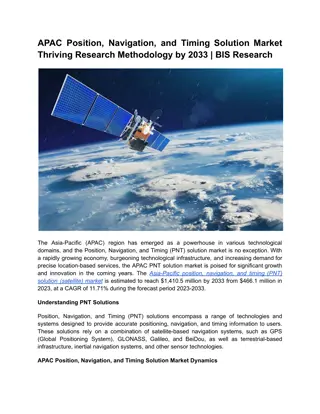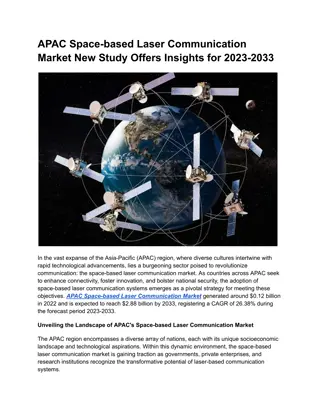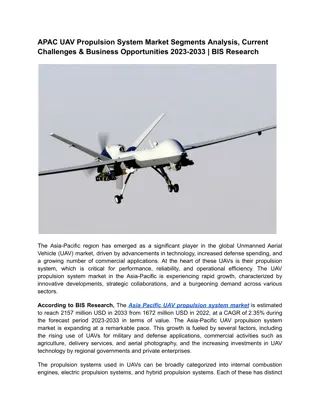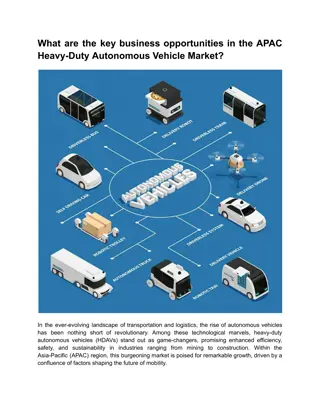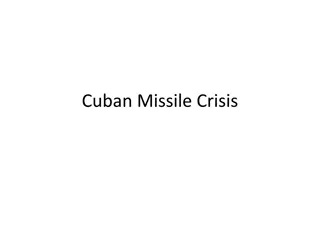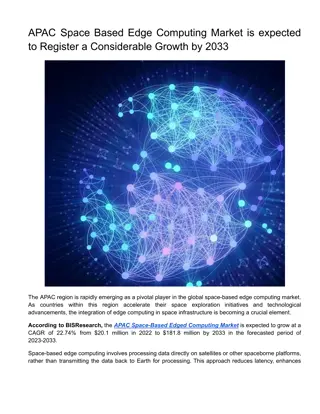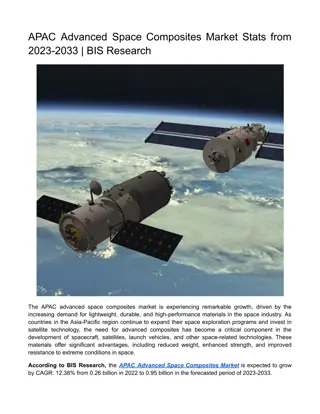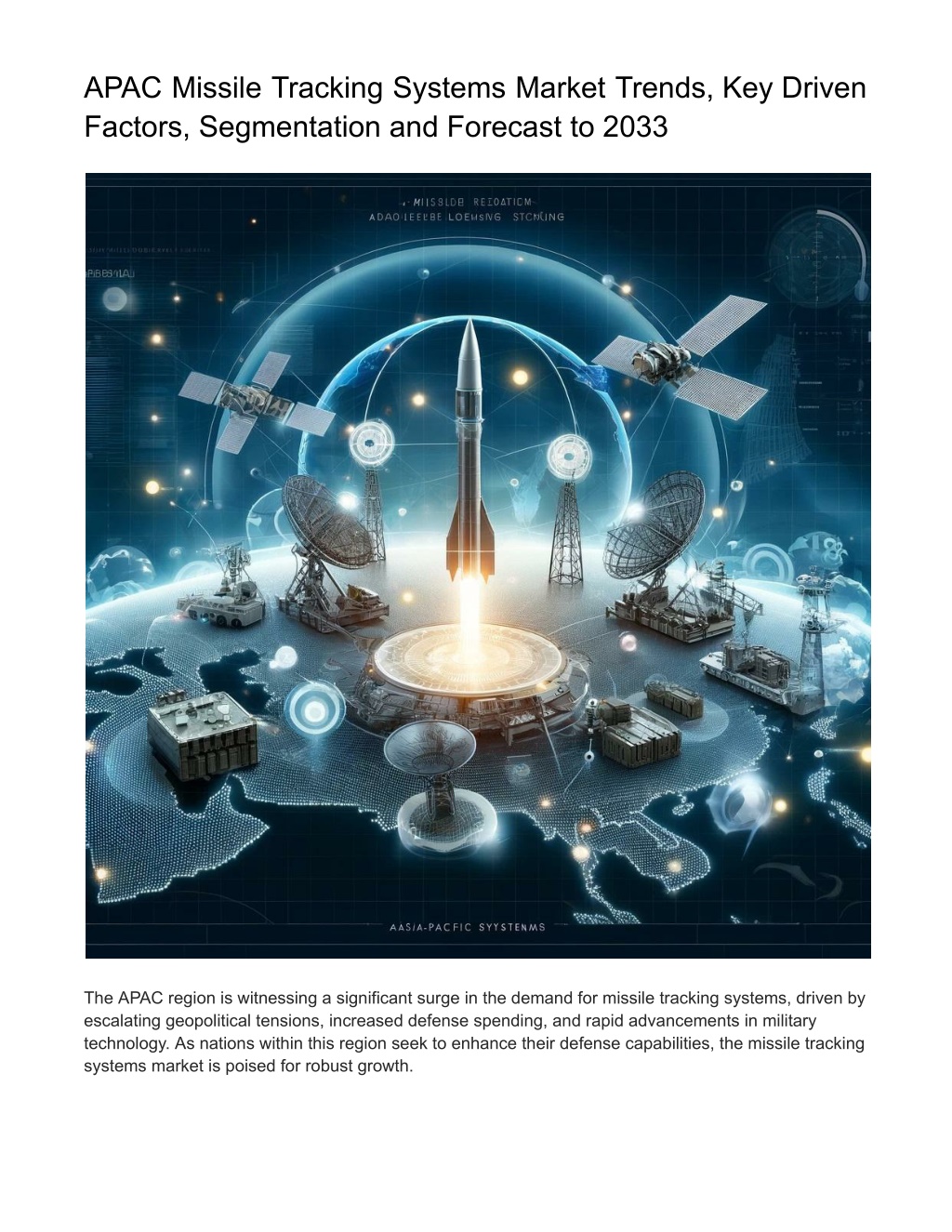
APAC Missile Tracking Systems Market
The APAC missile tracking systems market is projected to reach $27.81 billion by 2033 from $15.39 billion in 2023, growing at a CAGR of 6.09% during the forecast period 2023-2033.nnRead Report Overview: //bisresearch.com/industry-report/asia-pa
Download Presentation

Please find below an Image/Link to download the presentation.
The content on the website is provided AS IS for your information and personal use only. It may not be sold, licensed, or shared on other websites without obtaining consent from the author. If you encounter any issues during the download, it is possible that the publisher has removed the file from their server.
You are allowed to download the files provided on this website for personal or commercial use, subject to the condition that they are used lawfully. All files are the property of their respective owners.
The content on the website is provided AS IS for your information and personal use only. It may not be sold, licensed, or shared on other websites without obtaining consent from the author.
E N D
Presentation Transcript
APAC Missile Tracking Systems Market Trends, Key Driven Factors, Segmentation and Forecast to 2033 The APAC region is witnessing a significant surge in the demand for missile tracking systems, driven by escalating geopolitical tensions, increased defense spending, and rapid advancements in military technology. As nations within this region seek to enhance their defense capabilities, the missile tracking systems market is poised for robust growth.
According to BIS Research, The Asia-Pacific missile tracking systems market is projected to reach $27.81 billion by 2033 from $15.39 billion in 2023, growing at a CAGR of 6.09% during the forecast period 2023-2033. APAC Missile Tracking Systems Market Drivers 1. Geopolitical Tensions: The APAC region is marked by several territorial disputes and security concerns, notably in the South China Sea, the Korean Peninsula, and the India-Pakistan border. These geopolitical tensions have prompted countries to bolster their missile defense systems, thereby driving the demand for advanced missile tracking technologies. 2. Increasing Defense Budgets: Countries like China, India, Japan, and South Korea have significantly increased their defense budgets over the past decade. This rise in defense expenditure is aimed at modernizing military capabilities, including the acquisition of state-of-the-art missile tracking systems to ensure national security. 3. Technological Advancements: The advent of cutting-edge technologies such as artificial intelligence (AI), machine learning (ML), and advanced radar systems has revolutionized missile tracking capabilities. These technologies enable more precise detection, tracking, and interception of missile threats, making them indispensable for modern defense strategies. APAC Missile Tracking Systems Market by Application Target Acquisition Air Defense Space Domain Awareness Early Warning Capabilities Request A Free Detailed Sample on APAC Missile Tracking Systems Market! Technological Landscape in APAC Missile Tracking Systems Market 1. Advanced Radar Systems: Modern missile tracking systems leverage sophisticated radar technologies, including phased-array radars and synthetic aperture radars (SAR). These systems offer enhanced tracking accuracy and the ability to monitor multiple targets simultaneously. 2. Satellite-Based Tracking: The use of satellites for missile tracking has gained prominence, providing real-time data and extensive coverage. Satellite-based systems are crucial for early warning and long-range tracking, essential for effective missile defense. 3. Integration of AI and ML: AI and ML are transforming missile tracking systems by enabling predictive analytics and autonomous threat assessment. These technologies facilitate faster decision-making and improve the accuracy of tracking and intercepting missiles. APAC Missile Tracking Systems Market Challenges: High Costs: The development and deployment of advanced missile tracking systems are capital-intensive, posing a challenge for some countries with limited defense budgets.
Technological Complexity: The integration of cutting-edge technologies such as AI, ML, and advanced radar systems requires substantial expertise and technological infrastructure. APAC Missile Tracking Systems Market Opportunities: Rising Demand for UAVs: The increasing use of unmanned aerial vehicles (UAVs) for surveillance and reconnaissance creates opportunities for integrating missile tracking technologies into UAV platforms. Expansion in Emerging Markets: Emerging economies in the APAC region, such as Vietnam, Indonesia, and Malaysia, present untapped markets for missile tracking systems as they look to upgrade their defense capabilities. Download Our ToC: Click Here! Conclusion The APAC missile tracking systems market is on a growth trajectory, driven by geopolitical imperatives, rising defense budgets, and technological advancements. As countries in the region continue to prioritize national security, the demand for sophisticated missile tracking systems is expected to rise. With ongoing innovations and strategic collaborations, the market is set to evolve, offering significant opportunities for defense contractors and technology providers. The future of the APAC missile tracking systems market looks promising, poised to play a pivotal role in the region's defense landscape.

